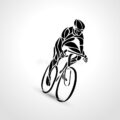What is the average speed of a pro cyclist?
The average speed of a professional cyclist while on flat terrain is 25-28 mph. This is quite a fast clip as an amateur cyclist will normally manage no more than 17-18 mph on flat terrain.
For many professional cyclists racing in the Tour de France, a fast speed on flat terrain makes it possible to stay competitive and keep up or surpass other cyclists on the circuit.
How much faster is a pro cyclist
As previously stated the average speed of a regular cyclist is about 17 to 18 mph as compared to the 25 to 28 mph for the award-winning tour rider.
On mountainous terrain, the average speed of a regular cyclist is about 9 to 10 mph while the Tour de France cyclist can go between 21 to 25 mph.
This is quite a blistering speed at almost double that of the regular cyclist mostly because of their better strength-to-weight ratios.
How fast do pro cyclists sprint?
The average speed of a professional cyclist on the road is about 63,9 kph which men can usually sustain for between 9 and 17 seconds while it is about 53.8 kph which women can sustain for between 10 to 30 seconds.

During such a sprint men’s peak power outputs average between 13.9 and 20 watts for every kilogram of weight while women top out at between 10.8 – 16.2 watts of power for every kilogram of weight.
However, it is not all about peak power when it comes to how to do a sprint as tactics are also a significant factor for pro cyclists. For instance, riders that adopt a forward standing position in a sprint can get a speed boost of up to 5 kph.
How fast are top cyclists on different terrain
Professional cyclists at the Olympics and the Tour de France tend to have different speeds on a range of terrain. This is to be expected as different terrain usually provides different obstacles, advantages, and disadvantages.
Average Speed on Flat Ground: 25-28 mph
The best professional cyclists riding on flat ground usually top out at between 25-28 mph. Most professional cyclists on the different tours ride at such high speeds which is perhaps why they get their very high average speed overall.
Average Cobblestone Speed: 22-24 mph
In every Tour de France race, the riders will usually have to tackle at least one cobblestone section in the cities. Sometimes that section is replaced with gravel pavement though this is rare.
The uneven terrain and the small grooves on the road usually make for difficult riding but most cyclists usually average between 22-24 mph which is quite impressive.
Average Speed Climbing: 12.8 mph
In the 2019 Tour de France edition, the average speed for the riders was 12.8 mph while tackling the tough climbs of the race.
The athletes usually have to ride up the slopes of the Alps and the Pyrenees during the climbing phase of the race. Given how hard they can be to tackle, these climbs are usually some of the most memorable moments of the Tour de France.

Fastest Recorded Speed at the Tour de France
The fastest speed ever recorded at the premier racing event was 63.1 mph which was set by the German Nils Pollit while descending the Col de Vars stage of the race.
Nils would become the first-ever cyclist to ever ride at 100 km/hr as his speed topped 101.5 km/hr riding down the descent.
Why are pro cyclists becoming faster over time?
Over the years, professional cyclists have been getting faster due to a variety of factors that include aerodynamics, technology, and training.
Aerodynamics
Bikes, bike apparel, and shoes have undergone major overhauls over the years in a quest for improving aerodynamics. We now have sleek helmets, disc wheels, updated frame geometry, ultra-light carbon fiber bikes, and aero bars.
Because of these updates reduces drag which then helps to increase speed. In fact, much of the high-tech clothing is more aerodynamic skin which is why most riders are required to show some skin to even out the playing field.
Training
As we learn more about training and racing techniques we improve how we approach the sport of cycling. While it was not possible to measure wattage in 1912, cyclists can now get instant feedback from all the many ways of measuring power and speed.
This makes it easier for riders to customize their training and also tailor their recovery periods.
Technology
Timing technology has come a long way and we can now capture a fraction of a second of cycling action. This means we can capture what may be minute record-breaking events on the track and on the road.
Things to Keep in Mind
Since cycling has changed so much over the years, it may not be so easy to track improvements in speed for professional cyclists as compared to athletes such as runners.
Nonetheless, advancements in aerodynamic technology continue to make it possible for riders to push the sport to its limits and break all manner of records.
Every Olympic race or Tour de France event seems to have at least one record broken in a category making professional cycling a very thrilling sport.


